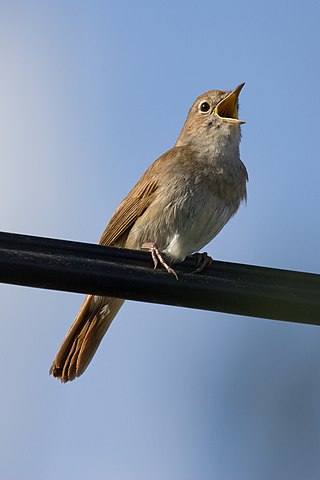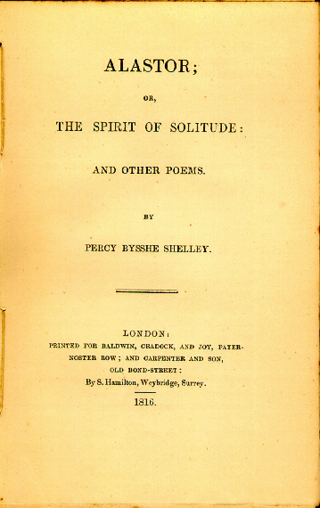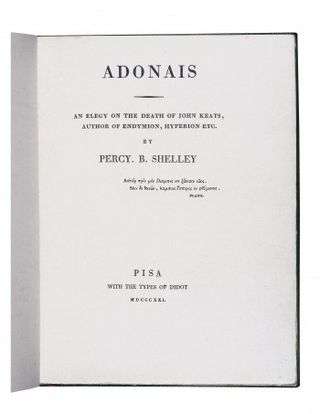
An ode is a type of lyric poetry. Odes are elaborately structured poems praising or glorifying an event or individual, describing nature intellectually as well as emotionally. A classic ode is structured in three major parts: the strophe, the antistrophe, and the epode. Different forms such as the homostrophic ode and the irregular ode also enter.

"Ozymandias" is a sonnet written by the English romantic poet Percy Bysshe Shelley (1792–1822). It was first published in the 11 January 1818 issue of The Examiner of London. The poem was included the following year in Shelley's collection Rosalind and Helen, A Modern Eclogue; with Other Poems, and in a posthumous compilation of his poems published in 1826.

The common nightingale, rufous nightingale or simply nightingale, is a small passerine bird best known for its powerful and beautiful song. It was formerly classed as a member of the thrush family Turdidae, but is now more generally considered to be an Old World flycatcher, Muscicapidae. It belongs to a group of more terrestrial species, often called chats.
This article contains information about the literary events and publications of 1819.

"Ode to a Nightingale" is a poem by John Keats written either in the garden of the Spaniards Inn, Hampstead, London or, according to Keats' friend Charles Armitage Brown, under a plum tree in the garden of Keats' house at Wentworth Place, also in Hampstead. According to Brown, a nightingale had built its nest near the house that he shared with Keats in the spring of 1819. Inspired by the bird's song, Keats composed the poem in one day. It soon became one of his 1819 odes and was first published in Annals of the Fine Arts the following July. The poem is one of the most frequently anthologized in the English language.

"Ode to the West Wind" is an ode, written by Percy Bysshe Shelley in 1819 in Cascine wood near Florence, Italy. It was originally published in 1820 by Charles Ollier in London as part of the collection Prometheus Unbound, A Lyrical Drama in Four Acts, With Other Poems. Perhaps more than anything else, Shelley wanted his message of reform and revolution spread, and the wind becomes the trope for spreading the word of change through the poet-prophet figure. Some also believe that the poem was written in response to the loss of his son, William in 1819. The ensuing pain influenced Shelley. The poem allegorises the role of the poet as the voice of change and revolution. At the time of composing this poem, Shelley without doubt had the Peterloo Massacre of August 1819 in mind. His other poems written at the same time—"The Masque of Anarchy", Prometheus Unbound, and "England in 1819"—take up these same themes of political change, revolution, and role of the poet.

Alastor, or The Spirit of Solitude is a poem by Percy Bysshe Shelley, written from 10 September to 14 December in 1815 in Bishopsgate, near Windsor Great Park and first published in 1816. The poem was without a title when Shelley passed it along to his contemporary and friend Thomas Love Peacock. The poem is 720 lines long. It is considered to be one of the first of Shelley's major poems.

Adonais: An Elegy on the Death of John Keats, Author of Endymion, Hyperion, etc. is a pastoral elegy written by Percy Bysshe Shelley for John Keats in 1821, and widely regarded as one of Shelley's best and best-known works. The poem, which is in 495 lines in 55 Spenserian stanzas, was composed in the spring of 1821 immediately after 11 April, when Shelley heard of Keats' death. It is a pastoral elegy, in the English tradition of John Milton's Lycidas. Shelley had studied and translated classical elegies. The title of the poem is modelled on ancient works, such as Achilleis, an epic poem by the 1st-century AD Roman poet Statius, and refers to the untimely death of the Greek Adonis, a god of fertility. Some critics suggest that Shelley used Virgil's tenth Eclogue, in praise of Cornelius Gallus, as a model.

"Hymn to Intellectual Beauty" is a poem written by Percy Bysshe Shelley in 1816 and published in 1817.

The Masque of Anarchy is a British political poem written in 1819 by Percy Bysshe Shelley following the Peterloo Massacre of that year. In his call for freedom, it is perhaps the first modern statement of the principle of nonviolent resistance.
Nationality words link to articles with information on the nation's poetry or literature.
Nationality words link to articles with information on the nation's poetry or literature.
Nationality words link to articles with information on the nation's poetry or literature.
"England in 1819" is a political sonnet by the English Romantic poet Percy Bysshe Shelley which reflects his liberal ideals.
John Hamilton Reynolds was an English poet, satirist, critic, and playwright. He was a close friend and correspondent of poet John Keats, whose letters to Reynolds constitute a significant body of Keats' poetic thought. Reynolds was also the brother-in-law of the writer and humorist Thomas Hood, who was married to his sister Jane.

Percy Bysshe Shelley was a British writer who is considered one of the major English Romantic poets. A radical in his poetry as well as in his political and social views, Shelley did not achieve fame during his lifetime, but recognition of his achievements in poetry grew steadily following his death, and he became an important influence on subsequent generations of poets, including Robert Browning, Algernon Charles Swinburne, Thomas Hardy, and W. B. Yeats. American literary critic Harold Bloom describes him as "a superb craftsman, a lyric poet without rival, and surely one of the most advanced sceptical intellects ever to write a poem."

Michael O'Neill was an English poet and scholar, specialising in the Romantic period and post-war poetry. He published four volumes of original poetry; his academic writing was praised as "beautifully and lucidly written".

The Triumph of Life was the last major work by Percy Bysshe Shelley before his death in 1822. The work was left unfinished. Shelley wrote the poem at Casa Magni in Lerici, Italy in the early summer of 1822. He modelled the poem, written in terza rima, on Petrarch's Trionfi and Dante's Divine Comedy.

Epipsychidion is a major poetical work published in 1821 by Percy Bysshe Shelley. The work was subtitled: Verses addressed to the noble and unfortunate Lady Emilia V—, now imprisoned in the convent of —. The title is Greek for "concerning or about a little soul", from epi, "around", "about"; and psychidion, "little soul".

"The Cloud" is a major 1820 poem written by Percy Bysshe Shelley. "The Cloud" was written during late 1819 or early 1820, and submitted for publication on 12 July 1820. The work was published in the 1820 collection Prometheus Unbound, A Lyrical Drama, in Four Acts, With Other Poems by Charles and James Ollier in London in August 1820. The work was proof-read by John Gisborne. There were multiple drafts of the poem. The poem consists of six stanzas in anapestic or antidactylus meter, a foot with two unaccented syllables followed by an accented syllable.


















